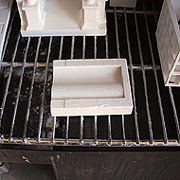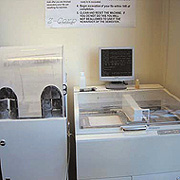|
The key decisions we made during this process were: a. the nature of the exchange and b. the characteristics of the object. The exchange was established initially around the action of small donations given on the exit of a gallery. Several options were run through, including the destruction of the object and the fabrication of the object by an artist. However, through a process of editing we decided that only one value characteristic was necessary. This value would be the literal value of whatever bill was inside the object. Having reduced the value to such a singular point, the nature of the exchange lay in what directions were assigned to it. The decision to assign minimum directions was intended to engage the subject in a deductive process, wherein over the course of their stay in the gallery some purpose or fate for the sheath would be slowly determined by them. Constructing a custom- made donation slot clearly indicating a suggested fate for the object was intended to speak to the visitor not in an instructive voice, but through the power of suggestion. Thus, the "desire" of the gallery was not explicitly stated and was left, instead, to some internal dialogue on the part of the visitor to sort out. Therefore, there were two primary decisions a visitor could make. They could either donate the money or keep it. They could interpret the money as a gift, or act of generosity, on the part of the gallery. Or they could interpret it as an opportunity for them to make a gift to the gallery instead. The decision to keep the money would at first seem to be a clear indication of selfishness. And to a large degree it may have been. But, beyond this initial reading, the decision to keep or give the bill can be interpreted as a larger suggestion as to the value of the gallery experience to the visitor. There are probably a number of complex motivations for giving or keeping the money. From being well-enough off that it may be of little value, to being dissatisfied with the work exhibited, to interpreting it as a sign of appreciation on the gallery's part. Whichever the reasoning, it indicates a position or understanding of the gallery visit on the part of the viewing public as either a valuable one, or one necessitating a greater degree of importance to supersede one's own monetary desires. To interpret it as a gift on the gallery's part may be read as an indication of the visitor's own estimation of their value in the gallery exhibition process. Whatever the case, the outcome of the experiment may not indicate an overall estimation or conclusion on the part of the limited community touched by it. Instead, it seems that its greatest value may lie in its nature as a vehicle through which to observe the actions and behaviors of individuals in response to it. Step 3. Outcome and Anecdotes. It seems there were several successes of the implementation of "Cacht." However, they were not what we initially expected. As I stated before, it seems that the process of the implementation and its use was the most successful. However, the notion of reciprocal generosity was neither clearly communicated nor clearly understood. |
    |